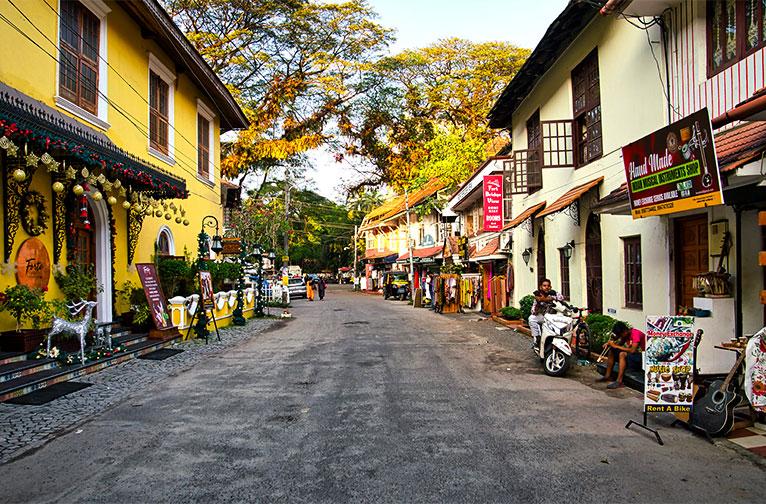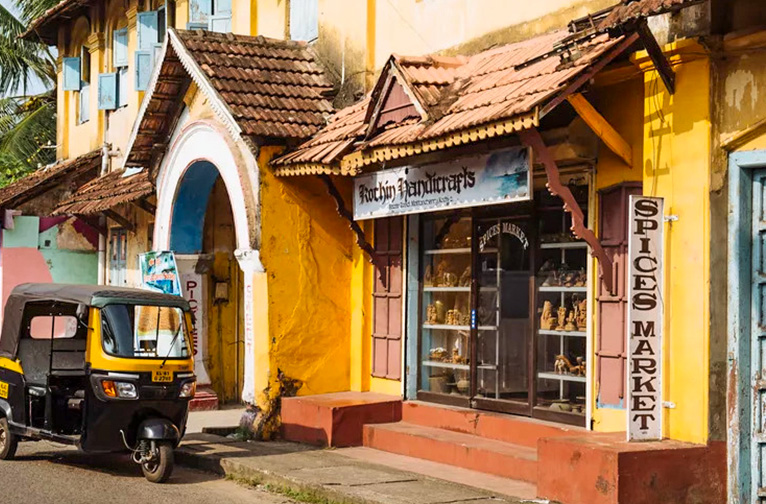History and heritage are woven so closely into the fabric of Kochi’s allurements as a tourist destination, even repeat visitors are surprised by how its contemporary world has embraced it all so seamlessly.
The fabled port town of Muziris, 25 km away on the Malabar Coast, vanished without a trace in 1341, drowned in the floodwaters created by the cataclysmic shift in the basin of the Periyar River. Traders, wringing their hands in despair, quickly looked for other harbour towns to shift their operations.


That was truly the big turning point in Cochin’s (present-day Kochi) fortunes, as sailing ships found their way into the natural harbour created by the same event and went on to conduct brisk business for centuries. On they came—the Arabs, the Romans, the Portuguese, the Dutch, and, in time, the English—all hungry to get a slice of the pie to feed their citizens back home with all the exotica Kochi had to offer, from pepper, the king of spices (of which the West could just not get enough), to high-value goods like sandalwood, ivory, gemstones, and even silk. Italian traveller Nicolas Conti got it right when he told his readers: "China is where you make your money, then Cochin is surely the place to spend it." Moroccan traveller Ibn Battuta marked the rising importance of Cochin as a port town from as far back as the 14th century.
Looking for Muziris
For history buffs, it’s interesting to note that it was a random rainstorm in the coastal town of Pattanam which revealed a few bare traces of what appeared to be a lost city. It appeared that this was quite possibly Muziris. It is widely speculated that Pattanam itself may be part of the lost port city. Explorations continue apace under the Muziris Heritage Project, one of the country’s biggest ongoing conservation projects today.
Influences of Political Upheavals
Cochin’s widespread connections with the ancient world through its trading operations and the active political machinations of those nations with the local rulers shaped its journey. The Kingdom of Cochin was a part of the extensive medieval-era Chera Empire, whose reach filtered across many parts of South India.
The vaulting ambition of the Zamorin of Calicut gobbled up the powers of the original local rulers of Cochin. Undeterred by the Zamorin’s rejection, the Portuguese quit Calicut and, instead of returning home with their tails between their legs, they quietly came and settled in Cochin. Business was just too good to leave for the hungry traders of other nations.
Portuguese navigator Pedro Álvares Cabral was the first to set up a Western settlement on Indian soil. He did this in Cochin in 1550. The Dutch came next in 1663, actively playing politics with the feuding Cochin royals. They had a firm grip on the Kingdom of Cochin until 1805. The ever-hungry East India Company quickly made its move with the death of Sakthan Thampuran.
Cochin eventually became a British Protectorate. The unwavering British hung on to it from 1814 to 1947, when they were kicked out as India gained independence. In 1956, the yesteryear provinces of Cochin, Malabar, and Travancore were gathered together to form what we know as the state of Kerala today.
A Cauldron of Cross-Cultural Thrills
The dazzling diversity of local and foreign influences was pivotal in transforming Kochi of yesteryears into an exotic cauldron of cross-cultural delights. Signing up for a curated walk across town with a knowledgeable guide can provide a truly rewarding immersive experience.
Heritage Sites
Fort Kochi is a good place to begin. Vasco House served as the home of Portuguese explorer Vasco Da Gama, who found a new sea route to India via the Cape of Good Hope. The Parade Ground, which was a bustling hub during colonial times, is where you’ll find locals playing cricket, football, or just hanging out catching the breeze. The iconic Chinese Fishing Nets will lure you into taking a ride on a fishing boat out on the waters for the morning catch and the photo sessions at the fish auction on the shore.
The architectural diversions of Kochi are truly eye-catching and offer a window to the port town’s lively past. Mainland Ernakulam is awash with structures from its Portuguese, Dutch, and English periods. At the Kochi International Pepper Exchange, revisit the historic past of this king of spices, also known as ‘Black Gold’, which had the Western world in turmoil for both its culinary and medicinal properties.
Bolghatty Palace, constructed by the Dutch in 1744, offers splendid panoramas of the bay. Once the home of the British Resident in the Raj era, it’s a popular heritage hotel run by KTDC.
The British made strenuous efforts to transform Willingdon Island into an important naval base. The bustling activities of Cochin Port, the Naval Airport, and the headquarters of the Southern Naval Command are gathered in its expansive embrace.
Mattancherry Palace dates back to the days of the Portuguese. Built in the mid-16th century, it is an atmospheric spot to linger and rewind to those volatile days of commercial and cultural exchanges.
The heritage zone of Mattancherry and Fort Kochi is an unmissable experience of Kochi’s dazzling past. This area is home to 39 distinct communities and is a virtual Tower of Babel as you wander around this linguistic paradise of plenty. If you are a culinary buff, you won't go home disappointed, as you wander around sampling diverse cuisines.
At Thripunithura, a short distance from Ernakulam, wend your way to the Hill Palace, the last seat of power of Cochin’s royal family. The massive structure includes a building dating to the times of Raja Ravi Verma, who ruled between 1853 and 1864. Run as a museum since the 70s, the palace has at least 15 galleries to explore the huge contributions of the Travancore and Cochin royals.
The contemporary vibrancy of Kochi is beautifully reflected in the port town’s burgeoning café culture. The coming together of art and culture is a heady experience as conversations flow richly and compellingly over cups of coffee and tea, ranging from history, heritage, and art to culture. Over three centuries old, a spice warehouse has transitioned into a lively cafe and nucleus for showcasing art.
Spiritual Diversity
St Thomas, one of Christ’s 12 disciples, arrived in 52 CE by ship at Kodungalloor, north of Kochi on the Malabar Coast. He was able to influence many locals, even the rich and well-to-do, to turn to the faith he preached through the Gospels in the region. He is said to have established Christian communities at Malliankara, Kodungallur; Kottakavu Church, North Paravoor; Niranam; Palayoor; Nilackal (Chayal); Kollam; and Thiruvithancode, the ‘half-church’.
The Syrian Christian communities in Kerala strongly believe in the hallowed tradition of St Thomas. Each year, on the 21st of December, they celebrate St Thomas Day. Kerala’s Syrian Christians are much reputed for their excellent culinary delights.
Jew Town is home to the famous Paradesi Synagogue. The first Jewish settlers arrived at Kodungallur in the 1st century CE. The Black or Malabari Jews were descendants of the original settlers, and the White (Paradesi) Jews arrived here as refugees from the Spanish Inquisition during the 15th and 16th centuries.
The Portuguese-built 16th-century St. Francis Church is located in Fort Kochi. It originally housed the mortal remains of Vasco Da Gama before they were taken back to Portugal 14 years later.
Kochi Backwaters
The network of waterways around Kochi offers visitors excellent opportunities to experience Kerala’s famous ‘backwaters’ adventures. Opt for small country boat tours to navigate the smaller channels to find lesser-known gems, which are hard to visit in the big houseboats.
Kochi has many hidden facets, and repeat visits are definitely recommended for even deeper immersions in this lovely tourist destination.